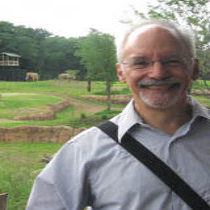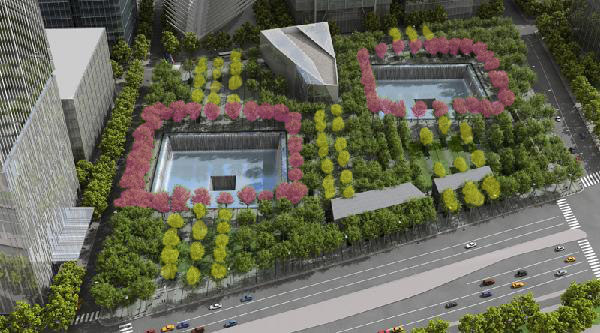Landscape Architecture for Landscape Architects › Forums › PLANTS & HORTICULTURE › 9/11 memorial Trees – Is anyone thinking?
- This topic has 1 reply, 6 voices, and was last updated 15 years, 2 months ago by
 Rob Halpern.
Rob Halpern.
-
AuthorPosts
-
September 28, 2010 at 12:29 pm #167644
 Rob HalpernParticipant
Rob HalpernParticipantIn today’s New York Times, an article about the choice of tree species for the 9/11 Memorial.
http://cityroom.blogs.nytimes.com/2010/09/27/many-mighty-oaks-but-not-a-single-sweet-gum/?ref=nyregionAs a horticulturist, 2 things jump out at me:
1. Sweet Gums make questionable trees for a massive paved site as the fruit can be quite a trip hazard and are certainly a clean-up issue. There are sterile hybrids, but there is no indication here that those were in the running.2. To plant 438 trees of the same species in one place may make a fine design statement, but is a risky choice culturally. Although a rather tough species, Quercus bicolor is as susceptible to assorted pests and disease as any (wilt, anthracnose, canker, dieback). 438 of the same species! Did we learn nothing from Dutch Elm Disease?
Forum members may be better than I at agreeing with the rationale for these choices. But how would you handle the realities of maintenance after Opening Day?
September 28, 2010 at 2:21 pm #167662 Rob HalpernParticipant
Rob HalpernParticipantYeah, and this project has to be the worst case!
Still, the issue of long-term maintenance is a real one. I just returned from a conference of grounds managers, all of whom had horror stories on new projects being designed that they did not have the resources to maintain. In my experience, the Owner is usually the prime mover in such delusional designs, but the result is further disrespect for landscape architects and designers in general.
September 28, 2010 at 3:03 pm #167661 Rob HalpernParticipant
Rob HalpernParticipantStill don’t know! If my new clients bite then I ought to be out of town. But nothing in this business ever happens when it was scheduled.
September 28, 2010 at 8:31 pm #167660 Trace OneParticipant
Trace OneParticipantThe article is about how they nixed the sweetgums in favor of swamp white oaks, right? Seems like a much better choice..
And while diseases do spread in monocultures, cities are one place that can be protected – There are even a few incredible elms remaining in New York , because they were in the ‘urban island’ and did not succumb to Dutch Elm..Although after the last storms, they may all be gone.
Monoculture is still not good, I agree.
September 28, 2010 at 9:23 pm #167659 Rob HalpernParticipant
Rob HalpernParticipantThe article explains how they were going to have a ribbon of sweet gums running through the mass of oaks. Now it’s all oaks
September 28, 2010 at 11:06 pm #167658 Thomas J. JohnsonParticipant
Thomas J. JohnsonParticipantMr. Halpern, You raise some good points!
It looks like the Sweetgums were eliminated from the design and replaced with the White Swamp Oak. While 400 Sweetgums might not have been the best choice, I’m not sure 400 Quercus bicolor is either. “…this species will develop chlorosis in high pH (very alkaline) soils, almost always the result of being transplanted into chalky and gravelly urban soils, usually near asphalt and/or concrete…” Besides the pests and diseases you mentioned, it doesn’t sound like an ideal environment for the species.
Of all the Oaks, Quercus bicolor is one of the least impressive but I guess that’s the point… “the original architect of the memorial, Michael Arad, began to fear in recent months that a swath of color in a discernible pattern might draw attention from the two great sunken pools marking where the twin towers stood.
“Especially in looking at the site from up above,” Mr. Arad said in an interview last week, “I felt the design — reduced to its most essential elements — was the twin voids. I really didn’t want to have anything that would distract from the clarity of that. I think a consensus emerged that the ring of sweet gums, at some level, obscured the clarity of that gesture.””
I have a solution that might satisfy both Mr. Walker’s desire to use Sweetgums and Mr. Arad’s desire to not have the species detract from his design…

Now the fall color of the Sweetgums emphasizes the pools, changing colors around the time of 911.
Here’s another option that uses the bright pink Sweetgums to ring the pools and another yellow species (ginko, maple, black walnut, etc) to line the alles leading to the sunken pools. Now, not only are the pools emphasized, the highlighted corridors lead people to them as well.

It seems that there are a host of other trees that would be better suited to the site than the White Swamp Oak… How about Silver Lindens, Lacebark Elms or White Ash?
P.S. I’m looking for work…
September 28, 2010 at 11:57 pm #167657 Trace OneParticipant
Trace OneParticipantHow about european lindens? Thomas, you have resorted to the usual problem with landscrapers – the need to decorate..As for the swamp white oak, I like them..no cancel that, I LOVE swamp white oak…..and I am NOT looking for work..
But I think the design was lost once it was taken away from the original conception of creating voids in the Hudson..That was a great idea..This is way too literal..September 29, 2010 at 12:05 am #167656 Dane K. SpencerParticipant
Dane K. SpencerParticipantAgree Rob. Monocultures are never a good idea, design not withstanding. Little difference if the choice is swamp white oak or sweet gum. And the reasons for switching species seems suspect. I can picture a brilliant red sea of foliage surrounding the two tower voids. I hardly believe that would have been a distraction. Yet, their should have been five different species or more, in my opinion.
September 29, 2010 at 12:33 am #167655 Thomas J. JohnsonParticipant
Thomas J. JohnsonParticipantTrace One – European Lindens would be a fine choice, except that they will attract honey bees and require a lot of water… but I proposed Silver Lindens, so the same applies there…
By the way, I’m not a “landscaper” and I don’t consider my alternatives “decorating”. I was proposing ideas that might satisfy both designers objectives. Really, I just wanted an excuse to crack open Photoshop and do something quick…
Besides, where do you draw the line between design and decorating. Is choosing a paving field and boarder decorating? Is selecting a complimentary capstone to a wall decorating. Is selecting a tree that is more appropriate for a site and that emphasizes the “most essential elements” decorating.
I’m glad that you love White Swamp Oaks. They are fine trees. Not my favorite Oak, but a fine tree… I prefer them alone, as opposed to 400 of them planted too closely together.
I’m glad that you’re not looking for work, good for you. A lot of us are. You shouldn’t be so cocky… although San Diego is probably a nice place to be homeless…
September 29, 2010 at 1:35 am #167654 Trace OneParticipant
Trace OneParticipantI like swamp white oaks, they are NOT common in Manhattan, while sweet gums are like callery pears..boring..and overused, street trees…… and the S. W. Oak is probably native to that original lower manhattan landscape….Just geussing..
And Mr. Thomas, I shouldn’t be cocky? pot and kettle problem?
but for me,that is a good thesis topic – when are we decorators and how to avoid that..I will Never forget laurie Olin telling us that our job ‘ is just to provide the ‘greenies around the building”…!!! Laurie Olin, when talking about Canary wharf – me, the angry political chick, had to try to call foul, and Ann Spirn shut me up, requireing obeisance to Laurie..
It is an issue for me..I don’t like to be a decorator, and see a very clear line, overall..Capstones, details are extremely important..But when you are decorating, i.e., shrubbing up an existing shape, it depressing to me..
I am about to be reprimanded for trying a no-water landscape, instead of the usual decorating on the highway…To me, if you taking out the social responsibility to the environment component, the design might as well be done by an interior decorator.. colors, texture – who cares, ultimately? Our job is one of responsibility to the earth..to the humans on the earth..Not to blend pretty colors…
September 29, 2010 at 3:04 am #167653 Jason T. RadiceParticipant
Jason T. RadiceParticipantThe Swamp White Oaks should have no problem in that area, they are really tough (thats why they were ultimately chosen over another species). Given the high-profile of this project, and its symbolism, there will not doubt be very high levels of maintenance. I’m sure all the soils are designed and are trucked in (hopefully the innoculate them), and arborists are certainly on the install teams to ensure proper soils, planting technique and proper irrigation. To do otherwise would be stupid, especially given the cost and quantities.
September 29, 2010 at 12:25 pm #167652 Rob HalpernParticipant
Rob HalpernParticipantI agree with all of that.
And continue to feel that a monoculture on this scale is a disaster waiting to happen.Sadly, it is getting more and more difficult to select good plants for some sites. Old standards do not hold and a monoculture based on historical assumptions is not a sustainable design. New insects and diseases are spreading (Asian long horned beetles, anyone? Or Sudden Oak Death in the West?) and the climate is changing (how many records for heat and rainfall have been broken in the past 3 months?). A site such as this, a void among tall buildings, has its own restraints: shade, wind, and – due to the underground constructions – limited root run. (Trace One, making a case that what was native two centuries ago is irrelevant today.)
September 29, 2010 at 1:31 pm #167651 Trace OneParticipant
Trace OneParticipantI completely disagree about two centuries ago being completely irrelevant, Rob… In the first place, even just considering what was there, originally, opens the normal landscrapers mind up a bit to possibilities…I think if another subdivison is planted with sweet gums, we will be able to see the impression of sweet gum foliage from satalites..(sp?)..
Secondly, the oak has suffered in the past two centuries, yes, but it was was there for a thousand years before that – doesn’t that count for something?
thirdly, as someone who ran park ranger tours in Brooklyn, and developed and conducted tours and classes around the Brooklyn Bridge, Lefferts Homestead, and Prospect Park, the history of new york is still very much there – and people love it..Yes, this is an extremely artificial site, and over time one has to choose one’s natives (ailanthus, anyone?), but I stick to my guns..“Completely Irrelevant” is a narrowminded and actually completely irrelevant comment.
Finally, despite or perhaps concomitant with my dislike of choosing plants for color, to my eye the natives ‘fit’ in the McHargian sense – the colors are right..Mexican Fan Palms are everywhere in the Central Valley, but they are not native, and the color scheme to my eye stands out..
September 29, 2010 at 1:41 pm #167650 Dane K. SpencerParticipant
Dane K. SpencerParticipantYou’re a big fan of the bagel garden then? (wink, wink)
September 29, 2010 at 1:54 pm #167649 Rob HalpernParticipant
Rob HalpernParticipantPerhaps we are looking at this from two different points. My reaction was that in a centuries old city, where Northeast woodlands (actually this area was underwater “originally”) have been completely replaced with structure and concrete/glass/steel the environment is entirely new. There is no “native.” And what was once native is not the most likely survivor of this new environment. In fact, Swamp White Oaks most probably were not native to anyplace within many miles of the site.
http://welikia.org/m-map.php?z=12You reject Liquidambar as over-used but then advocate for native palette. Liquidambar is more appropriate from an historical perspective than Q. bicolor. So how are you making these decisions?
-
AuthorPosts
- You must be logged in to reply to this topic.


